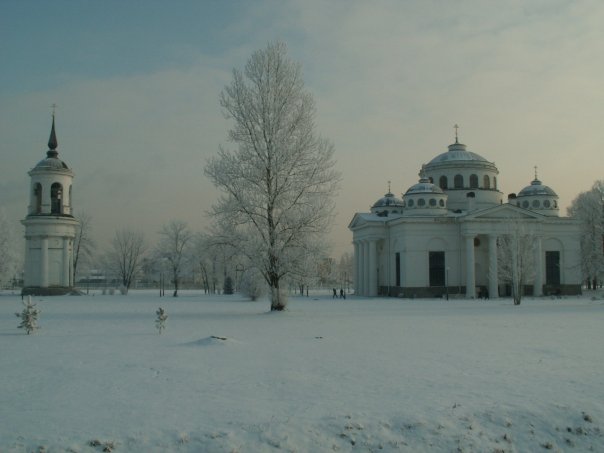- Sophia Cathedral
Infobox religious building
building_name = St. Sophia (Ascension) Cathedral Софийский (Вознесенский) собор
infobox_width = 300px

image_size = 300px
caption = St. Sophia Cathedral and itsbell tower in winter 2008
map_type =
map_size =
map_caption =
location =Russia ,Saint Petersburg ,Tsarskoye Selo
geo = coord|59|42|18.89|N|30|23|38.05|E|type:landmark_region:RU_scale:2000
latitude =
longitude =
religious_affiliation =Russian Orthodox
rite =Orthodox
region =
state =Russia
province =
territory =
prefecture =
sector =
district =
cercle =
municipality =Saint Petersburg ,Tsarskoye Selo
consecration_year = 1788 (1989, 1999)
status =Cathedral
functional_status = Active
heritage_designation =
leadership =
website =
architecture = yes
architect = Charles Cameron,Ivan Starov ; the bell tower -Leon Benois
architecture_type = Cathedral
architecture_style = Palladian
general_contractor =
facade_direction = West
groundbreaking = 1782
year_completed = 1788
construction_cost =
specifications = yes
capacity = 5,000
length =
width =
width_nave =
height_max =
dome_quantity = 5
dome_height_outer =
dome_height_inner =
dome_dia_outer =
dome_dia_inner =
minaret_quantity =
minaret_height =
spire_quantity = Stone,granite
spire_height =
materials =
nrhp =
added =
refnum =
designated =Infobox church
name =
fullname =
color =
imagesize = 300px
caption =
landscape = yes
denomination =
diocese = Saint Petersburg and Ladoga
division = Tsarskoe Selo
parish = St. Sophia Cathedral
subdivision =
founded_date =
founder =
architect =
style =
constructed_date =
dedicated_date =
closed_date =
demolished_date =
bishop =
priest =
archdeacon =
dean = Rev. Gennadiy Zverev
provost =
rector =
canon =
prebendary =
curate =
chaplain =
vicar =
deacon =
abbot =
minister =
seniorpastor =
pastor =
address = 1, Sofiyskaya pl., Tsarskoye Selo, St. Petersburg Санкт-Петербург, Царское Село, Софийская пл., 1
country = "flagicon|Russia
phone = +7 812 465-30-19
website =The Ascension Cathedral in the town of Sophia (now a part of Pushkin) in the vicinity of
Saint Petersburg , was one of the first purelyPalladian churches to be built inRussia . Rather paradoxically, it may also be defined as "the first example of Byzantinism inRussian architecture " [Anthony Cross. "By the Banks of the Neva". Cambridge University Press, 1996. ISBN 0-521-55293-1. Page 292.] .The cathedral was founded in July 1782 at the instigation of
Catherine II of Russia . The Tsarina, eager to liberateConstantinople from the Turks, wished to have a replica of theHagia Sophia in the proximity of theCatherine Palace where she spent her summers. In addition, the cathedral was to be the chapter church of the newly establishedOrder of Saint Vladimir .The Empress called upon her favourite architect, Charles Cameron, to design this "Byzantinesque" church, but the Scottish architect, though well versed in the Palladian idiom, had a vague idea of what
Byzantine architecture stood for. His design called for an austere and monumental whitewashed exterior, with Doric porticoes on each side, probably a reference to the works of Lord Burlington.Construction works, supervised by
Ivan Starov , lasted for six years. In the eventual variant, the five wide domes were placed on squat drums, vaguely reminiscent of theHagia Eirene . The church was consecrated on28 May ,1788 in the presence of the Empress. During the two decades that followed, theImperial Academy of Arts had the interior adorned with Neoclassical paintings. A detached two-storied belltower was added considerably later, in 1905, to a design byLeon Benois .In 1817,
Alexander I of Russia gave the cathedral to ahussar regiment of hisLeib Guard , which was quartered in Sophia. During the rest of the 19th century, the regiment had the cathedral transformed into a sort of military museum, its walls lined with marble plaques honouring the hussars' victories. Near the altar, for instance, were placed the banners captured by General Cherniaev from the Khan ofKokand .In 1934, the Communist government had the cathedral closed down, with marble plaques and precious furnishings either nationalized or stolen. It stood abandoned until 1990, when the
Russian Orthodox Church resumed worship there. The same year, a bust ofAlexander Nevsky was added nearby, by way of commemorating the 750th anniversary of theBattle of the Neva .Inline references
Online references
* [http://www.alexanderpalace.org/palace/sophia.html Sophia Cathedral on the Alexander Palace Time Machine] - history, pictures, floorplans
* [http://www.alexanderpalace.org/2006tsarskoe/sophia_cathedral.html Sophia Cathedral, Kazan Cemetery and nearby Hospitals] - from Tsarskoe Selo in 1910
Wikimedia Foundation. 2010.
